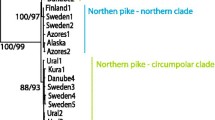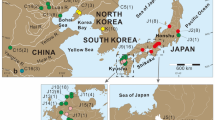Abstract
To elucidate the genetic population structure of Pseudogobio esocinus (Cyprinidae) in central Honshu, Japan, we performed phylogeographic analysis based on partial mitochondrial cytochrome b gene sequences. We found not only differentiation of mtDNA lineages between basins (uncorrected p ≈ 2%), presumably associated with uplifting of the Suzuka Mountains in the early Pleistocene, but also more diverged two mtDNA lineages within basins (p ≈ 8%). No evidence of mtDNA introgression from related sympatric species was found. The phylogeographic history of these two lineages should be elucidated by further analysis based on the specimens of P. esocinus from the entire distribution range.


Similar content being viewed by others
References
Aoyama S, Watanabe S, Ishikawa S, Nishida M, Tsukamoto K (1999) Are morphological characters distinctive enough to discriminate between two species of freshwater eels, Anguilla celebesensis and A. interioris? Ichthyol Res 47:157–161
Avise JC (2000) Phylogeography: the history and formation of species. Harvard University Press, Cambridge
Banarescu P, Nalbant TT (1965) Revision of Pseudogobio (Psces, Cyprinidae) with notes on related genera. Rev Roum Biol Ser Zool 10:301–308
Excoffier L, Laval G, Schneider S (2005) Arlequin ver. 3.0: an integrated software package for population genetics data analysis. Evol Bioinform Online 1:47–50
Horikawa M, Mukai T (2007) Distribution of mitochondrial DNA haplotypes of a cyprinid fish, Biwia zezera, in the Nobi Plain, Japan. Bull Biogeogr Soc Jpn 62:29–34
Horikawa M, Nakajima J, Mukai T (2007) Distribution of native and non-native mtDNA haplotypes in northern Kyushu population of Biwia zezera, Japan. Jpn J Ichthyol 54:149–159
Hosoya K (2001) Kamatsuka. In: Kawanabe H, Mizuno N, Hosoya K (eds) Freshwater fishes of Japan, 3rd edn. Yama-Kei, Tokyo, pp 314–315
Kawabe T (1989) Stratigraphy of the lower part of the Kobiwako Group around Ueno basin, Kinki district, Japan. J Geosci Osaka City Univ 32:39–52
Kitagawa T, Watanabe M, Kitagawa E, Yoshioka M, Kashiwagi M, Okazaki T (2003) Phylogeography and the maternal origin of the tetraploid form of the Japanese spined loach, Cobitis biwae, revealed by mitochondrial DNA analysis. Ichthyol Res 50:318–325
Lu YL, Luo PQ, Chen YY (1977) Gobioninae. In: Wu XW (ed) The cyprinid fishes of China, vol 2. Science Press, Peking, pp 439–549
Nakamura M (1969) Cyprinid fishes of Japan. Spec Publ Res Inst Nat Resour, Tokyo, pp 143–148
Nei M, Tajima F, Tateno Y (1983) Accuracy of estimated phylogenetic trees from molecular data. II. Gene frequency data. J Mol Evol 19:153–170
Palumbi SR, Martin A, Romano S, McMillan MO, Stice L (1991) The simple fool’s guide to PCR. Department of Zoology and Kewalo Marine Laboratory, University of Hawaii, Honolulu
Posada D, Crandall KA (1998) MODELTEST: testing the model of DNA substitution. Bioinformatics 14:817–818
Saitou N, Nei M (1987) The neighbor-joining method: a new method for reconstructing phylogenetic trees. Mol Biol Evol 4:406–425
Saka R, Takehana Y, Suguro N, Sakaizumi M (2003) Genetic population structure of Lefua echigonia inferred from allozymic and mitochondrial cytochrome b variations. Ichthyol Res 50:301–309
Sakai T, Mihara M, Shitara H, Yonekawa H, Hosoya K, Miyazaki J (2003) Phylogenetic relationships and intraspecific variations of loaches of the genus Lefua (Balitoridae, Cypriniformes). Zool Sci 20:501–514
Shimizu T, Taniguchi N, Mizuno N (1993) An electrophoretic study of genetic differentiation of a Japanese freshwater goby, Rhinogobius flumineus. Jpn J Ichthyol 39:329–343
Swofford DL (2002) PAUP 4.0b10a: phylogenetic analysis using parsimony (and other methods). Sinauer, Sunderland
Tamura K, Nei M (1993) Estimation of the number of nucleotide substitutions in the control region of mitochondrial DNA in humans and chimpanzees. Mol Biol Evol 10:512–526
Tamura K, Dudley J, Nei M, Kumar S (2007) MEGA4: molecular evolutionary genetics analysis (MEGA) software version 4.0. Mol Biol Evol 24:1596–1599
Watanabe K (1998) Parsimony analysis of the distribution pattern of Japanese primary freshwater fishes, and its application to the distribution of the bagrid catfishes. Ichthyol Res 45:259–270
Watanabe K, Mori S, Nishida M (2003) Genetic relationships and origin of two geographic groups of the freshwater threespine stickleback, ‘Hariyo’. Zool Sci 20:265–274
Watanabe K, Takahashi H, Kitamura A, Yokoyama R, Kitagawa T, Takeshima H, Sato S, Yamamoto S, Takehana Y, Mukai T, Ohara K, Iguch K (2006) Biogeographical history of Japanese freshwater fishes: phylogeographic approaches and perspectives. Jpn J Ichthyol 53:1–38
Yang J, He S, Freyhof J, Witte K, Liu H (2006) The phylogenetic relationships of the Gobioninae (Teleostei: Cyprinidae) inferred from mitochondrial cytochrome b gene sequences. Hydrobiologia 553:255–266
Yue PQ (1998) Gobioninae. In: Chen YY (ed) Fauna Sinica, Osteichthyes, Cypriniforms II. Science Press, Beijing, pp 232–389
Zardoya R, Doadrio I (1999) Molecular evidence on the evolutionary and biogeographical patterns of European cyprinids. J Mol Evol 49:227–237
Acknowledgments
We are very grateful to T. Asaka, S. Kanao, J. Kitamura, T. Komiya, H. Ogawa, H. Yamane, and J. Nakajima for providing specimens and information. We also thank M. Nishida for lending us experimental instruments. This study was partially supported by Grants-in-Aid from the Ministry of Education, Culture, Sports, Science, and Technology, Japan (no. 18570086, Biodiversity Research of the 21st Century COE: A14, and “Formation of a Strategic Base for Biodiversity and Evolutionary Research: from Genome to Ecosystem” of the GCOE), and by the Foundation of River and Watershed Environment (“Beautifying and Greening the Riverside Environment”).
Author information
Authors and Affiliations
Corresponding author
About this article
Cite this article
Tominaga, K., Watanabe, K., Kakioka, R. et al. Two highly divergent mitochondrial DNA lineages within Pseudogobio esocinus populations in central Honshu, Japan. Ichthyol Res 56, 195–199 (2009). https://doi.org/10.1007/s10228-008-0071-0
Received:
Revised:
Accepted:
Published:
Issue Date:
DOI: https://doi.org/10.1007/s10228-008-0071-0




